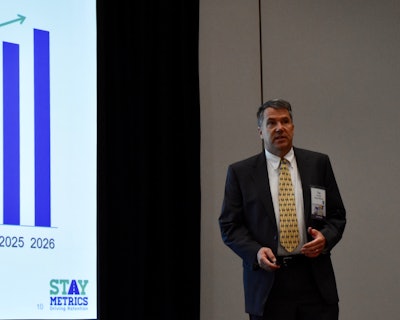 Tim Hindes, chief executive of Stay Metrics, recently spoke at the Trimble in.sight conference.
Tim Hindes, chief executive of Stay Metrics, recently spoke at the Trimble in.sight conference.Stay Metrics, a provider of evidence-based driver feedback, engagement, training and retention technology and services, has released the latest version of its client-facing web portal with new reporting tools that give motor carriers insights to prevent early driver turnover.
Ongoing research by Stay Metrics shows that 57 percent of newly hired drivers quit their carriers within the first 180 days of employment. Of these drivers, about 35 percent leave within the first 90 days.
As a neutral third party, Stay Metrics administers a suite of Driver Survey products for carriers during critical time points for new drivers, approximately 7 and 45 days after their hire date. With the updated Stay Metrics Reportal, Version 1.2, carriers have full visibility to individual driver survey responses through reports that identify drivers with an elevated risk of leaving.
“One of our core values at Stay Metrics is to ‘never quit getting better.’ Through gathering feedback and suggestions from our clients, we have developed innovative reporting tools and actionable insights for preventing early driver turnover,” said Tim Hindes, co-founder and CEO of Stay Metrics.
The Orientation Surveys serve as an early warning system by sending immediate email alerts to carriers if driver responses to questions in the 7-Day and 45-Day surveys fall outside predefined ranges.
With the new reporting tools, Stay Metrics’ clients are able to select a report (Day 7, Day 45 or Exit Survey) and date range to view individual driver responses. Selecting a 45-Day report shows comparative data for drivers that took both the 7-Day and 45-Day surveys to identify any changes in attitudes or perceptions towards their jobs based on early experiences.
The report shows driver responses to a Net Promoter Score (NPS) question and the average NPS score of the report group. Also shown in the report are driver responses to Likert Scale-style questions using values of 1 to 5 that represent their levels of satisfaction or dissatisfaction.
The new reporting uses color-coding to identify areas of improvement or decline between the 7-Day to the 45-Day surveys. Users also can view transcribed comments from drivers to any question.
“The 7-Day survey is an effective way to measure if recruiters are setting realistic expectations for drivers and the quality of the orientation experience. The 45-Day survey identifies areas of early disconnect and job dissatisfaction,” explains Hindes.
“NPS scores are a measure of whether or not carriers are meeting driver expectations. Analysis of our collective survey data show that drivers with higher NPS scores at 45 days are leaving their carriers at half the rate (19 percent) of drivers that lower their scores between the 7-Day and 45-Day surveys,” he continues.











